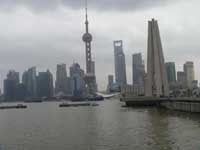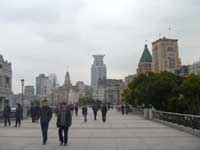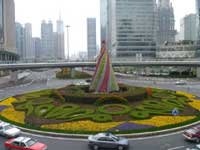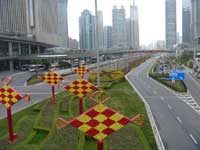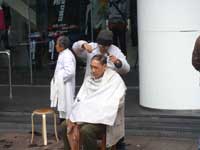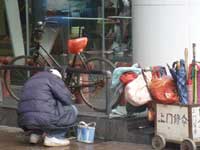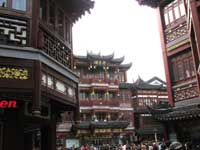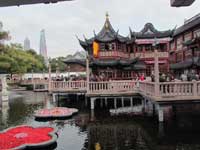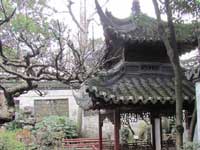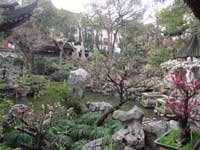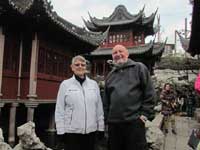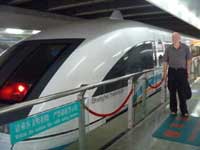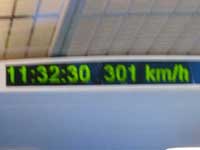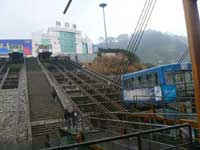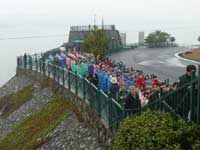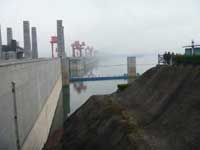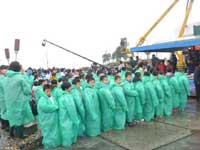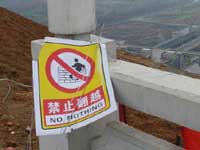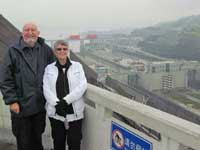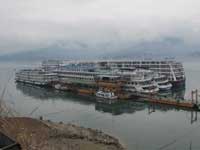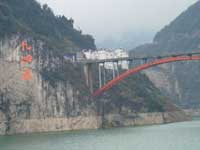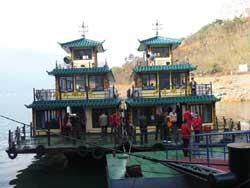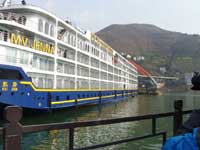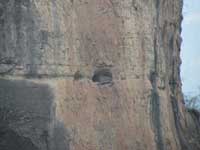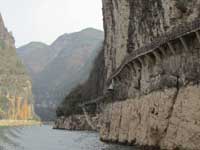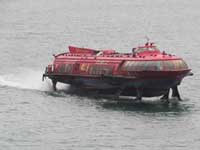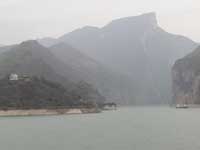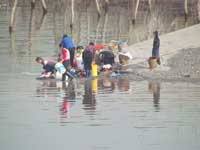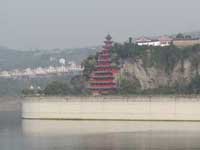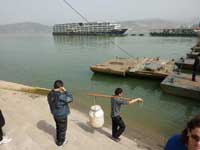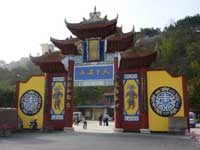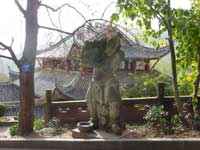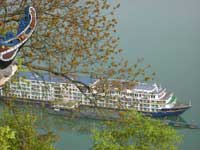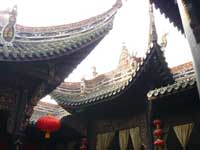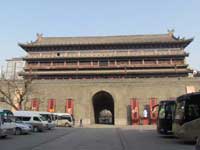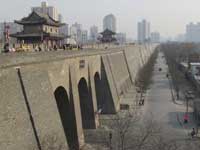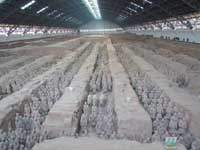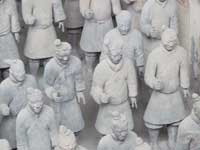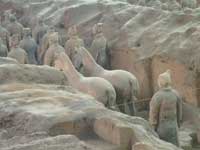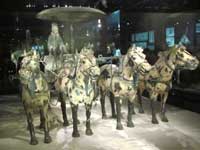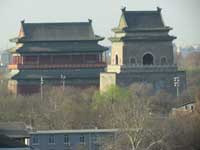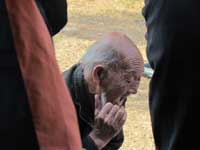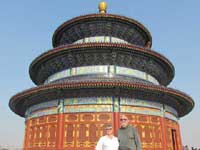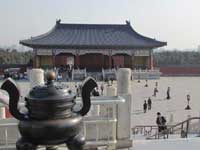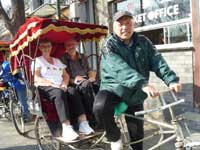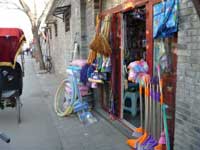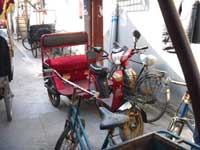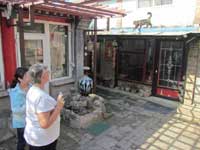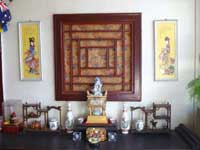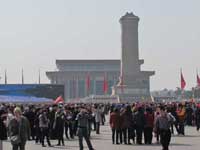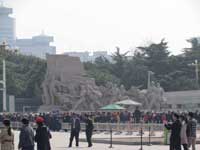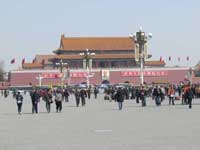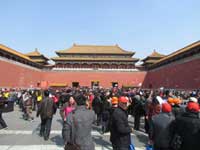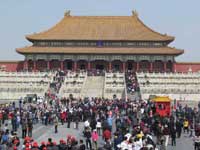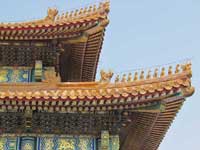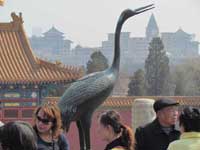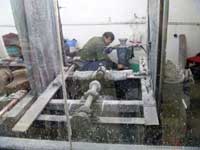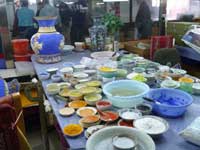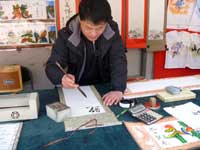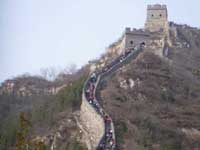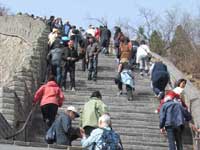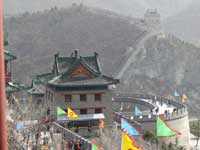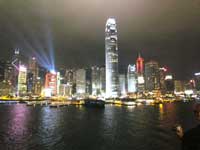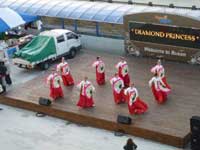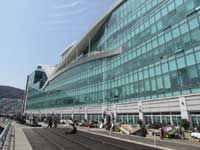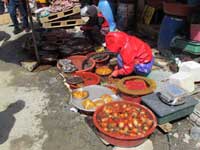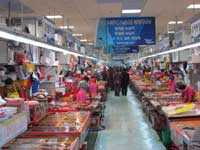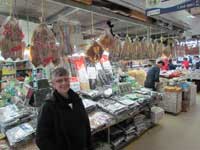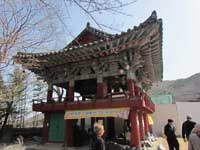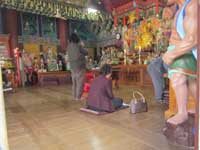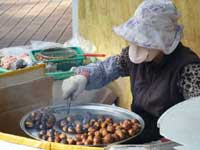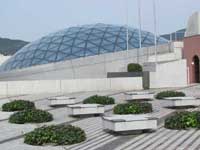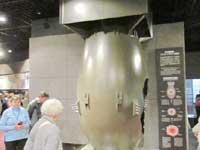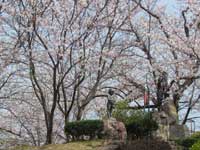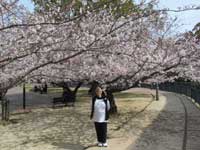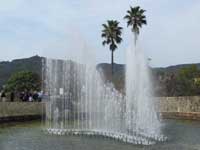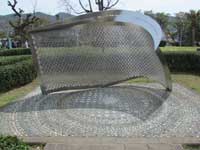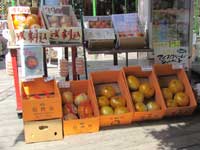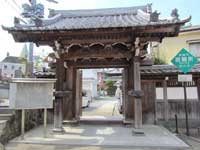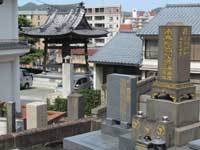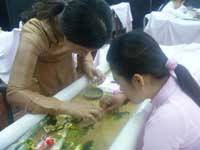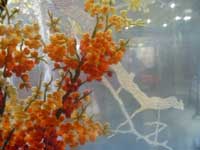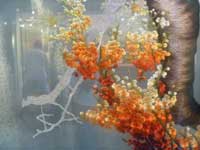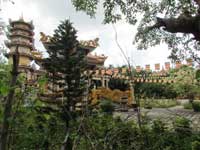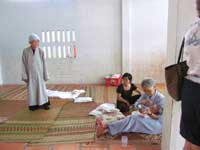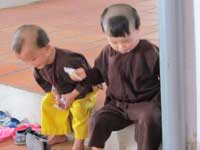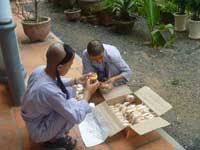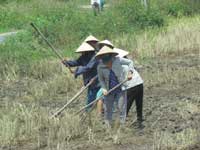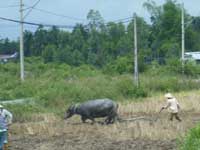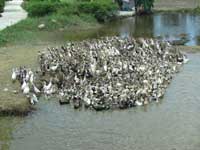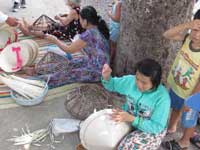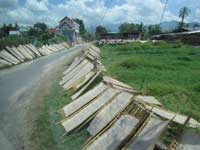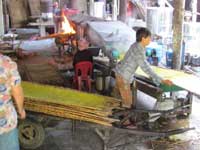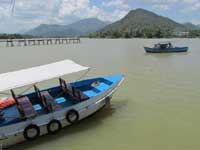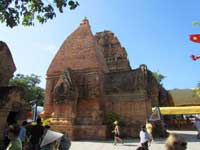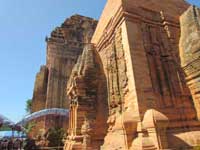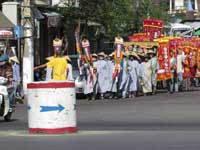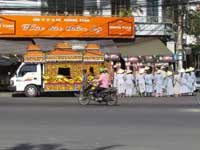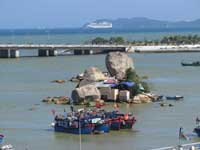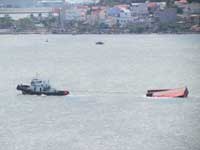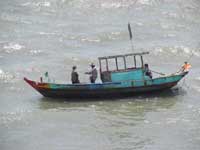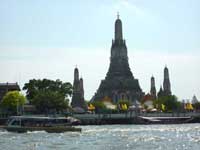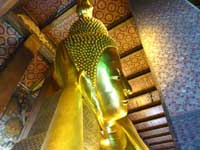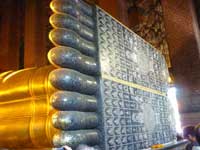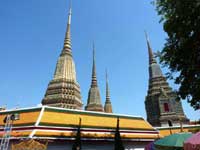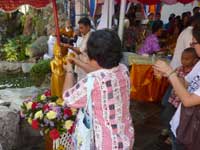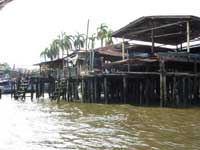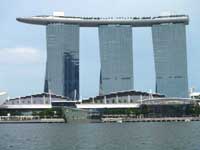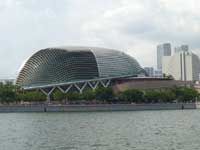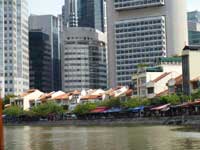A month in China and South-East Asia in March and April 2012 on land and on Diamond Princess
China - Ancient and Modern (download 1.4MB PDF file) | Asia Revisited (1.2MB PDF file) | Maps | Cartoon
China - Ancient & Modern
Shanghai
We arrived safely at Shanghai Airport at 6.30am after the 12 hour overnight flight from Auckland. We were met by Cindy, our delightful tour guide (the first of many) and driver. After an hour and a half we arrived in the city and our hotel. We elected to check in, have a rest and be refreshed and ready for our introduction to the city at noon. Our city tour showed us the new city, especially the riverfront area, and The Bund, which is a long esplanade planted with flower beds and fronting many of the old colonial buildings which speak of Shanghai’s colourful and multicultural past. Many of these buildings were built in the late 19th and early 20th centuries by the British, French and other European merchants and settlers. The HSBC building is really impressive and looks more like an ornate Catholic Cathedral than a bank, with incredible gilded mosaics depicting 'God shining on the righteous' i.e. the white traders and bankers! There were also mosaics showing the signs of the zodiac and others showing scenes from the other countries the bank operated in ... no sign or mention of the Chinese at all! Sadly, photography was not allowed.
Across the river is the ultra-modern part of the city, called Pudong, which wasn't even built when Martin visited the city in the late '80s, when it was all muddy subsistence farms, and The Bund was knee-deep in litter and filth. Some of the modern architecture is fascinating and imaginative and some is definitely not; no surprise to learn that the 'not' was the responsibility of the (Soviet) Russians. They were the only friends China had after the 'Great Leap Forward' and 'Cultural Revolution' and they got away with just about anything they wanted.
We were then taken on a walk to look at a traffic roundabout. We were a bit puzzled until we got there and saw that it is actually a beautiful garden with an elevated walkway round it. It was a popular strolling place for families and young couples and had it not been for the cars grand-prixing around it, with attendant fumes, it would have been a tranquil spot for taking the air!
Something which struck us very forcibly while walking in Shanghai was the number of times we had our photographs taken, sometimes surreptitiously and sometimes quite openly. When one chap ran up to us, grabbed Martin’s arm and posed while his companion took a photo, we asked the guide what was going on. She explained that the photographers were almost certainly from remote parts of China where they never see a foreigner. Apparently they come to cities like Shanghai purely to see westerners, so in effect, we were the tourist attraction. It happened in other places, too, but was far more noticeable here. Once we understood, we were happy to pose with anyone who asked, and their children – but felt rather sorry for them that a pair of geriatric wrinklies was the most exciting thing they had ever encountered. Martin’s height and white beard made him a particular target for the shutter-bugs!
The next day was not only very cold but also very wet. Fortunately we started by visiting the excellent museum where we saw the most beautiful calligraphy, paintings, ceramics and, best of all, ancient jade artefacts and ornaments. Some were quite exquisitely and finely worked, and dated from 5000 years BC! The exhibits were very well displayed and labelled in English and Chinese. There were also informative, illustrated explanatory leaflets available in each section, all free of charge.
The rain had stopped by the time we had finished at the museum and went to a silk factory. The process was very interesting and Sarah was surprised at the different aspects of manufacture and the various qualities of silk and how it is graded. Of course, the hard sell followed but we were a sad disappointment to them as our wallets remained firmly closed.
Lunch was next followed by a walk down Nanjing Road, the main shopping street, which was interesting for the old umbrella mender squatting at the side of the road and also the barber cutting hair on a chair set up on the pavement ... same sheet round the shoulders, comb and scissors for every customer!
There were some interesting shops selling everything from recognisable western lollies (including Hershey’s Kisses, Reese's Peanut Buttercups and Snickers bars) to dried fruits, vegetables and unmentionable animal parts, as well as bottles of stuff we really didn't want to know about. The most interesting thing was the prices in the shop, which started at 1 or 2 Yuan but went up to several thousand Yuan - all mixed up together and not under lock and key or armed guard as we would have expected. The exchange rate was approximately US$1= 7 Yuan, NZ$1 = 5 Yuan and £1 = 10Yuan.
The ancient city was next and this was exactly as one would expect ancient China to look, with curved-roofed, tiled buildings, cobbled courtyards and all. Most of the buildings were reconstructions but there were enough old ones left to show us that they were good reproductions so we did get a feel for what it must have beem like. Also here are the Yu Gardens which are genuinely ancient, and very beautiful, with lots of rockeries, streams, lakes, bridges, pavilions and many varieties of trees and plants. The plum blossom was just coming out and smelled lovely. There is a very famous Tea Rooms in the middle of the lake but we spent so long in the gardens we decided we could live without experiencing a half-hour tea ceremony followed by an expensive cup of slightly yellow hot water and so we dodged into Starbucks (Oh, the shame!) for ten minutes instead - and thawed out with a ruinously expensive coffee.
Dinner was followed by an acrobatic show which was simply stupendous. The girls were so supple we were sure they'd had their bones removed and the men, who looked very puny and had the sort of hairstyles the likely lads in western pop groups favour, were actually very strong and able to hold, balance and throw each other around the stage without any obvious effort. There were some very young acrobats - around five or six years old – who did really well and were quite funny, tumbling, playing tricks on the adults and pretending to sabotage their acts.
Now for a slight chronological ‘cheat’: We returned to Shanghai two weeks later, on our ‘Princess’ cruise, but will report on that visit here, for continuity’s sake.
We started by catching the shuttle bus from the port into town and then got the Metro to the Maglev station. This is the magnetic levitation train which was featured on some of the scientific programmes on Discovery and National Geographic TV (Richard Hammond or James May almost certainly!). It runs from downtown Shanghai to the international airport and is the only commercially functioning one in the world - and likely to remain so given the enormous cost to make and run it. We decided to take a ride and got very excited when the display showed us we had got up to 301kph. It was only Y60 each and worth all of that for the thrill and experience. We did the journey, which had taken an hour and a half by car, in 7 minutes!
After returning to the city, by cheap Metro (Y18 for an all day ticket) which took nearly an hour, we went to one of the massive shopping complexes which sold every imaginable faked designer brand handbag, watch and electronics, plus myriad computer programs and games. What an awful experience! We were accosted even before we got out of the Metro station and were subjected to a barrage of shopkeepers trying to drag us into their stores - it was all really off-putting. The watches are not on open sale but blokes in dirty t-shirts sidle up to you with tatty photos saying "Want to by real fake Lolex?" They then take you to a shop where there is ordinary merchandise on sale, open a 'cupboard' and take you through to a room where you will buy a watch. We had been warned about this and decided that we didn't fancy that scenario, so came away empty-handed but with clear consciences. Apart from that, we're also told that the ‘knockoff’ merchandise is no longer the bargain it used to be. No doubt the presence of 3,000 cruise passengers in town did a bit to raise prices, too.
We then went back to Nanjing Road where there were such crowds (it was a public holiday) that we dodged into a big, modern Mall and treated ourselves to (another) Starbucks coffee and croissant, plus choccy cake, for late lunch; we felt we'd earned it! Actually it had become a point of honour to have another coffee in a Starbucks in Shanghai because when we were there before, we went to one and filled out a survey, which gave us a free coffee next time we went, but only in Shanghai. Given the cost of coffee in China (Y50 or thereabouts), there was no way we were going to pass that up!
Now back to the original schedule:
Yichang
The next morning we were picked up and taken to the airport for our flight to the biggest small town you never heard of, Yichang, where we were to catch our river boat. All went smoothly and the hour and 40 minute flight was as comfortable as could be hoped for. Martin indulged in the lunch, beef with rice and pickled vegetables (that's what they said it was, anyway - he said it didn't taste of anything in particular) but Sarah wasn’t hungry enough. We were on the ground before we knew we were even close as it was very foggy and soggy, but at least we got there - we later met some people who had been rained and fogged out and been brought to the boat by a very circuitous route, including a 5-hour bus drive. This was not the only time we had cause to be grateful that we were travelling as a party of two and were thus spared many of the inconveniences and ‘herding’ suffered by those in larger groups.
We were met by another very good guide, Helen, and driver and taken for a tour of the city - about as exciting as any suburban dormitory town but much, much bigger (4 million inhabitants) and less beautiful. To be fair, the fog and rain didn't help and we felt really sorry for the guide who told us that they usually took people for a walk along the riverside park. We took pity on her and said we'd be happy to do that too - but maybe for 20 minutes not a full hour! Actually it was moderately interesting in its way and the rain did stop and the fog lifted slightly so we could see the barges and other river craft - and the new railway bridge, which was clearly a huge source of pride and joy! We think the guide was quite glad when we asked if it was possible to go to a shop selling Nokia as the battery on our phone had given up the ghost. We went to a Nokia shop but they didn't have a genuine battery and wanted quite a lot for a generic make. The guide wouldn't let us buy from them and took us to a smaller shop where we got the same battery for a good deal less. It turned out the shop we went to belonged to the driver's best mate! The battery is working fine, so all is well.
On that subject, was it coincidence or very scary x-ray scanners at airports in China which made not only Sarah’s phone battery but also Martin’s watch battery and our computer mouse fail? We spoke to other people we met on our trip, and on the cruise later, many of whom reported the mysterious failure of sundry batteries and electronic equipment while in China. No doubt it will remain a mystery.
The shopping filled some time so it wasn’t too early to go to the restaurant for dinner before joining the ship. Fortunately Martin thought to ask if it was possible to have something a bit spicy (we had really had enough of the bland, oily stuff). The guide was delighted and ordered us a really lovely meal including a delicious chicken, chilli and nut dish called Gom (or Hom) Bao Chicken. She told us they usually give Westerners plain food - wish we'd thought to mention it earlier in the trip, but now we knew!
Yangtze River
The locks on the Three Gorges Dam were closed for maintenance so we didn't get to go through them, which was disappointing. It also meant the ship was moored upstream from Yichang, above the dam, so we had an hour and a half drive in the dark and rain to get to it. We then had to negotiate some very interesting cable cars down the river bank to the quayside where we had to clamber through several other vessels to reach ours. We were, again, delighted that we had booked privately as we had a porter to carry our bags (one at each end of a bamboo pole) while everyone in a regular tour party had to manage their own.
The welcome was warm and the cabin comfortable and modern. Very few of the staff spoke English, which was a challenge, especially as the American cruise director never seems to be about when required! To be fair, the passengers were mainly Chinese (200 and only 28 Westerners) so we were very much in the minority.
Next morning, we toured the Three Gorges Dam and its visitor centre. It is very impressive, especially when one considers it was built using the minimum of technology and maximum man power - they spent a long time justifying the necessity to build it but we remain unconvinced.
Also visiting the Dam were hundreds, possibly even a thousand, school
children. It was International Water Conservation Day (who knew?) and
they were there to learn about water conservation. They stood, clad in
overlarge plastic macs, without their heads covered, however, in the pouring
rain (how ironic!), in serried ranks and absolute silence while a lecturer
harangued them at inordinate length. Then, all of a sudden, they started
singing and chanting in perfect unison and waving bits of blue ribbon
around. All very bewildering until one of our number asked a nearby teacher
what was happening and she explained it all – and told us the blue ribbon
represented water… of course it did! It was all being filmed and we wondered
if they, and possibly we tourists, might be on that night’s television
news.
Once that part of their visit was over they were given pamphlets to distribute
and it was obviously a point of great pride to give as many as possible
to the foreigners who had shown such an interest in them. We ended up
with several as we simply couldn’t bear the look of disappointment on
the slower ones’ faces when they saw we had already been got at. They
were, of course, all in Chinese, but our grandsons found them interesting
and the drawings needed no translation.
After the visit to the Dam, we started sailing up the river through beautiful scenery; mist-shrouded and very cold, but quite awe-inspiring nonetheless and reminiscent of the beautiful paintings we saw in the museum in Shanghai. We also saw many of the ‘Relocation Villages’, to which the people were forced to move when their villages were submerged. These are joyless, utilitarian blocks with populations in the hundreds of thousands to millions (some ‘village’!) and it is no surprise that the older residents were not happy with them. Apparently the young people are more content because there is more work available for them but the older generation are totally bewildered and cannot come to terms with being removed from their ancestors, poor souls. Ancestor-worship is very important to them and they believe they should never abandon their traditional villages where the ghosts of their ancestors still walk. Many were given the choice of leaving their ancestors undisturbed but no longer accessible, or having them exhumed and their graves moved to their new villages where they could still be visited and cleaned at the appropriate time. This was really no solution, however, as it is as bad to disturb their final resting place as it is to neglect to visit and tend it.
We had four nights on the river boat as we elected to travel upstream, which takes a day longer than the other way and meant that we could see more on the way as progress was more leisurely. The gorges were all as beautiful as each other and quite breathtaking in parts. Before the dam was built, the water was only between 30cm and 1m deep, so not navigable, but now it is between 150m and 175m deep and one can only imagine how the cliffs and mountains would have dwarfed everything in the valley in those days – they certainly seemed high enough now!
Along the way we passed villages old and new, farms, factories and beautiful temples, seemingly in the middle of nowhere. At Wushan we left our boat and embarked on smaller ‘ferries’, actually rather ornate pleasure boats, so that we could navigate the narrow arm of the ‘small gorges’ up the narrow Shendong Stream, to see monkeys and mountain goats, the ‘Hanging Coffin’, a covered bridge clinging to a sheer cliff side, a precarious hut on another hillside, where we were serenaded by a musician playing traditional instruments – all quite surreal! The Hanging Coffin was actually placed in the mouth of a shallow cave, about 100 metres up a sheer cliff and no-one has yet quite worked out how the coffin, presumably with its incumbent, was manhandled up, or possibly down, the cliff and put in place. This was done hundreds of years ago so there would have been no machinery to aid the process.
We then transferred to still smaller boats and were taken up an even narrower inlet to see still grander mountains and where we encountered a boat in which a man stood and sang snippets of folk songs. The cynics amongst us assumed that it was a fleece-the-tourists ploy but there was no question of approaching him or any expectation of payment; presumably he did it for pure enjoyment. We returned to Wushan and rejoined ‘Victoria Jenna’ before setting sail once again. We passed the vertiginous ‘Godess Mountain’ with its craggy summit and, one would swear, the figure of a Goddess standing on top, silhouetted against the sky. The lovely White Emperor City with its stone bridge and pagoda, stood guard over the Qui Gate, a fine engraving of which is to be found on the Y10 note.
Possibly our absolutely favourite place is Shibaozhai (I can spell it but can’t say it!) where there is the most exquisite red pagoda, built into the rocks on its own little island. It is almost impossible to do justice to it in writing so you will have to look at the photograph to appreciate its beauty. It was here, also, that we saw the villagers doing their laundry in the river, near the pagoda. This was the place, above all others, which we felt epitomised the real, heartland of China, rather than the brash modern cities or even the standard ‘sights’.
The last afternoon of the cruise was at Fengdu, the Ghost City, but as
it was on top of a mountain and only to be reached on foot, by means of
steep steps and paths, Sarah cried off. Martin went and said that it was
a lot of effort for something "quite interesting" so she felt
she had made the right decision. There was a fairly good view from river
level so she didn't miss out altogether. The modern city of Fengdu is
barely visible about 80 metres away on the opposite bank of the river,
shrouded in pollution. The guide told Martin that they were lucky to be
there on a clear, sunny day as it is not often that it can be seen at
all!
Chinese jollity and get dressed up in Imperial Robes for a ‘photo-opportunity’
(the things we do for our grandsons!). Every evening on the boat, we had
been treated to the most extraordinarily professional displays of dancing,
musicianship and traditional folklore, all played by members of the crew.
We felt sure that they must have been trained performers first and waiters,
chambermaids etc. second – although their The Captain's Farewell Banquet
rounded off the day and our final act as passengers was to join the exemplary
execution of their more mundane duties indicated that they were highly
trained in these, too.
Chongqing
We had a very strange day after we left the boat and before going to the airport. Chongqing is a city of some 32million inhabitants, recently made famous throughout the world by the murder of an old Harrovian, British ‘fixer’ and the deposing of the province’s most colourful politician. Apart from the Great Hall of the People (which these people weren't allowed to enter) and the Peoples Park, which we were, there is nothing to do nor anything of beauty to see. It was a smoggy day (when isn't it?) but we were told we were lucky to have such good visibility ... hmmm, have you spotted a theme here? There is an interesting Immigrant Museum (the ‘immigrants’ came from other parts of China) and where we had a good guide who explained everything very well. Of course we ended up in the gift shop but there was nothing we wanted to buy so we were told it would be acceptable to just 'feed the Buddha' - i.e. make a donation!
The museum took up about an hour but the poor guide still had to fill in time so took us to see the magnificent new bridge. This was built in three distinct styles as it had been started by the Russians then they fell out so the Chinese carried on with the construction but ran out of money so the 'people of Macao' finished it off to the celebrate their return to the fold of the Chinese Motherland ( a year after Hong Kong). It was the most appalling example of a building project you've never seen and we're staggered it's still standing! We're glad we hadn't known its history before we were driven over it! After a lunch of Hom (or Gom) Bao chicken (again - word had obviously spread through the Tour Guide grapevine as we were to have this dish in some form for virtually every ‘included’ meal during the rest of our trip!) we were taken to the airport where we caught the plane to Xi’an.
Xi’an
We got to Xi'an about 3pm and were greeted by yet another delightful; guide and driver – Cathy was our favourite and we became quite fond of her during our short stay in Xi’an. She was very excited when she saw Martin as she was proud to have responsibility for “the tallest and most bearded” tourist to alight from our plane! We were taken to see the ancient city walls which extend13km right round the ancient city and it is, apparently, possible to walk and ride bikes along them – we didn’t but lots of people did and one had to keep ones wits about one to avoid being bowled by an over-enthusiastic but rather less than observant cyclist! Words cannot do them justice but the photos might give you an idea. There are ornate buildings and pagodas and the whole of the ancient city is quite stunning. We hadn't realised that Xi'an is one of the oldest (ex) capital cities in the world and had been home to most of the major dynasties and their emperors. In the evening we went to an Imperial Dumpling Banquet followed by an excellent display of traditional song and dance.
The next day was dedicated to the Terracotta Warriors. Awesome is a much over-used word these days but it is the only one to describe the sight of all those thousands of figures arising from the ground – all different in feature and dress, but all the same height and in perfect serried ranks. (Their orderliness evoked a fleeting memory of all those school children at the Three Gorges Dam!) We were also able to see some of the areas still being excavated and it was extraordinary to see a boot here and a head there, still half buried – quite breathtaking. The site is enormous and we spent almost a day there and still didn't do it all justice, though there is a saturation point and after that it's hard to take in any more information. If we had seen and done nothing else on this trip, Xi'an would have made it all worthwhile.
Beijing
Another internal flight took us smoothly to Beijing. Our first visit
in that extraordinary city was to the circular Temple of Heaven, which
is quite exquisite and, we discovered, every bit as beautiful as the Forbidden
City. What we also particularly liked were the gardens and colonnades,
which are used as public recreation areas and where we saw children playing
games, old men playing a type of Chinese chess, others playing two-stringed
bowed instruments (surprisingly tuneful!), people practicing Tai Chi and
sundry other exercise routines, so rhythmically that it was almost like
watching a dance. There were also couples posing for their wedding photographs,
something we were to see again outside the walls of the Forbidden City.
Concentrating on the game Temple of Heaven Outbuildings of the Temple
of Heaven
Something else we noticed was that all children under the age three of
wear trousers which don't have a crotch seam and neither do they wear
undies or nappies. Sarah was about to take a photo (from behind) of one
chirpy little chappy when he squatted to do what nature intended and she
rather lost the desire for a picture (or lunch!).
We also visited a hutong (these are old walled villages with traditional
courtyard houses), most of which were bulldozed before the Olympics. We
were taken round in a trishaw, which was a novel experience, to say the
least. We met one of the residents in his home and were surprised to encounter
a long-haired, western-dressed gentleman of obvious means, not the poor
peasant we expected! It appears that only the very wealthy can afford
houses in the hutongs nowadays. Even though, in truth, they are hardly
better than hovels, they are now some of the most expensive real estate
in China. Actually, we shouldn't have been surprised because all the cars
parked around the hutongs were Lexus, Mercedes, BMW, Audi and the like!
We visited Tiananmen Square, with its huge portrait of Chairman Mao at
the main gate. Seeing it, we remembered the terrible events which took
place there. Today the square was just as crowded as the TV pictures of
that time showed but this time with tourists - literally thousands and
99% of them Chinese. Having heard Mao and the Cultural Revolution soundly
panned and nothing but criticism from all our other guides, we were very
surprised when our Beijing guide told us that her parents almost revered
Mao for improving their lives beyond all their dreams. It seems that they
were impoverished farmers eking out a living, going hungry when the crops
failed and being treated like animals, used as beasts of burden and whipping
boys by the landowners in their village. We then realised that the other
guides had come from professional families, who had been brought to their
knees by the revolution. It was interesting to hear this side of the story
and get a further insight into the real situation of those times. A measure
of Mao’s influence can be gauged by the size of the queue waiting to visit
his tomb.
The Forbidden City was next and everything you have ever seen or read about it cannot do it justice. The magnificence of the architecture and decorations are quite stupendous and we hope that these photos will give you an idea of the crowds and, in spite of them, the splendour of it all... though you will have seen pictures in books and television films about it, so we probably aren’t adding much to what you already know. There are so many parts to walk through to get to the Central Hall that it was a bit like climbing a mountain: just as you think you're there, another, grander building comes into view. Again, the hundreds of tour groups made it a busy and noisy experience, and it was hard to imagine the serenity which must have been the case when it only housed the Emperor and his household!
Great Wall
We spent the next day at the Great Wall, and climbed a little bit of it, along with thousands of other, again mainly Chinese, tourists. The steps were huge and hand rails precarious or non-existant so Sarah decided discretion was the better part of valour and that honour had been satisfied after half a dozen or so steps; Martin made the same decision about 100 steps later, having realised that coming down would be even trickier than the ascent. Still, we can say we’ve done it and, as with the Terracotta Warriors, it made the whole China experience so memorable.
There was surprisingly little commerce at the gates to the Wall but there was a calligrapher and we commissioned him to make a scroll with our family’s names in characters. It was fascinating to watch him work out the syllables and then translate them into characters – though whether thay bear any resemblance to the originalsbut it doesn’t matter because it’s a lovely work of art in itself:
For lunch we were taken to a simply enormous tourist restaurant where the food was OK-ish but the government sponsored cloisonné workshop downstairs was really interesting - just for once we didn't mind being taken to a shop. But we did refuse to detour to a jade factory (also government sponsored) on the way back to the hotel ... and had to give the guide a signed waiver to say we had refused to go, otherwise she would have got into trouble. I suspect that had we not shopped for cloisonné we would have been frog-marched to the jade place, like it or not. The Chinese have taken to capitalism with gusto!
The Olympic Village was obviously a source of pride but we found it rather disappointing and soulless. The Water Cube wasn’t a cube but rather a single-story block, which looked as though it was clad in blue bubble-wrap (albeit with very large bubbles) and neither it, nor the rather scrappy ‘Birds Nest’, both of which had looked so spectacular on television, actually lived up to their promise. We were told that they were in regular use by the general public and various sports and swimming clubs but someone we spoke to later, who had gone to see them and have a swim in the ‘cube’ said they were firmly closed and there was no evidence that they were in use at all. Who knows? There were some extraordinary modern buildings, mainly apartment blocks, and we were told that these had housed the athletes during the games. They were offered for sale to private buyers in advance of the games, with the proviso that the purchasers could not take possession until afterwards and the price would depend on the eminence and success of the athlete who had occupied it – and even with these caveats every single one was sold before the games started!
On our last night in Beijing we were taken to the original Peking duck restaurant, Qύan jù dė, which started in 1864 as a hawker stall but now has dining rooms on two storeys and is really quite opulent. The duck was delicious and a bonus was being able to see into the kitchen and watch it all being prepared. I suspect that in very few of China’s restaurants would that be a welcome or appetising sight!
We left Beijing, travelling with the guide, Margaret, and driver who had looked after us so well in that city, and made our way to the port of Tianjin, about two hours drive away. The scenery was pretty featureless but we saw a lot of old farms and temples in daily use, showing the same architectural and decorative features, but with none of the colour and gilding of the more famous ones, and so arguably more typical than those. The farming methods are still archaic and manual labour the norm. There was no machinery to be seen anywhere but very ancient, bent and wizened men and women doing the backbreaking work of cultivation. Out of the modern cities with their fantastic, futuristic, sparkling glass towers of offices and conspicuous displays of obscene wealth, the country seems to recede several hundred years into the past... so much for the cultural revolution!
When we arrived in Tianjin we were in for a huge shock: Since the third day of our Yangtze cruise the weather had steadily improved and by the time we got to Beijing it was hot and sunny – definitely t-shirt weather and the sunshine stayed with us all the way to Tianjn. As we left the car at the cruise terminal however, we were almost knocked over by the icy wind, blowing at gale force. We rapidly donned our (woefully inadequate) jackets which we were only carrying because of lack of room in our cases. We were bent double into the searingly dry wind as we made the short walk into the terminal, but even this was enough to scour any exposed skin and Sarah’s hands became chapped and sore within the 10 minutes we were exposed. We learnt afterwards that the temperature was 4oC (it was 25C in Beijing the day before) but that the windchill had put it well below freezing.
Now for another chronological digression: We called at Hong Kong on our Princess cruise but will write about it here as it is part of China so, geographically, should be included with the rest of that country.
Hong Kong
Having lived there for two years from ’89 to ’91 we thought we knew Hong Kong but how wrong we were! Luckily, we had arranged to spend the day with our erstwhile next-door neighbours, Dee and Geoff Lovegrove who proved to be not only wonderful companions (as always) but also excellent tour guides. Not only had the container terminal where we docked not existed when we lived there, neither did the land on which it was built! A shuttle bus ride to Kowloon’s Ocean Terminal revealed an array of multi-lane roads, buildings and ongoing development on the reclaimed land. We met at the new YMCA and found that although HK had changed beyond recognition, our friends had not and the 21 years since we had last seen them just melted away.
Geoff had planned a great day for us which included using as many forms of transport as could be fitted in, travelling over as much ‘new’ land and as many new roads, bridges and railways as possible.
We used to live in Discovery Bay on Lantau Island which was then a small enclave of pleasant flats and maisonettes, with just a few shops, a bank, restaurant and social club. The only way to get there was by ferry from Central, which took around 30 minutes, and then walk the few minutes to our flat – and that was it … no other means of transport to and from HK Island. The only mode of transport in DB was a limited number of golf buggies. Now it is a huge development accessible by road with bus connections to the subway. The airport and Disneyland are nearby although not really noticeable in DB itself. We went there by a combination of buses and saw our old flat which seemed unchanged in among the surrounding high-rise blocks, before returning to Hong Kong island by fast jet ferry.
It was Easter Saturday when we were there and the beach and esplanade were crowded with families waiting for their chance to dig up an Easter Egg – lots of jollity and loudspeakers but sadly for us, it was not at all the quiet and peaceful retreat from the bustle of the city we remember.
All that filled the morning and we were ready for lunch by the time the ferry got us back to Central. Geoff, who is a dab hand at finding taxis, secured one even before the rest of us had left the disembarkation ramp and we were whisked to the elegance of the Hong Kong Club. Here we had an excellent curry lunch, waited on by one particular ‘ancient retainer’ whom one could imagine had been there since the old colonial times, aeons before HK was returned to China in 1997…
After lunch we walked through to the Star Ferry and headed back to Kowloon side. It was only then that we realized that we hadn’t seen any of the famous trams. There has been so much reclamation that the street on which they travel is now well back from the waterfront, rather than just one road away.
We walked through the Ocean Terminal shopping centre, which seemed to consist entirely of (genuine) designer stores, all apparently doing a roaring trade. Afternoon tea at a Mövenpick restaurant was a treat and, although conversation had flowed all day, it provided a final opportunity to catch up on any last minute news before we had to catch the shuttle bus back to the port and our ship.
Our departure from Hong Kong provided a magnificent Grand Finale to our China experience: As a special concession, the port authorities let us sail away through Victoria Harbour, between Central and Kowloon, and we were astonished to see that the ship nearly filled the channel, so much reclamation has been done. Every night there is a 'Symphony of Light' show which comprises a few lasers shooting across from each side and all the big buildings being lit up with multi-colours, amazing moving patterns and generally thoroughly OTT consumption of power! Apparently the government started the idea at the height of the SARS epidemic to cheer people up and it was so popular they've kept it going.
Random observations in no particular order:
• All the guides were surprised at how much we had read about China,
it’s geography, economic and political systems.
• They were also surprised to learn that NZ and China are strong trade
partners in both directions.
• China smells of lavatories (even clean ones!), incense, vegetation,
garlic, rancid fat, drains fermented bean curd and diesel/petrol fumes…
even in the beautiful countryside.
• All the guides were young women (early 30s) who introduced themselves
by English first names (Cindy, Helen, Cathy, Margaret) whereas the drivers
were all addressed as Mr Wong, Mr Liu, Mr Chin, Mr Li. We wondered why?
It seemed demeaning to the women but maybe not as bad as having their
Chinese names mis-pronounced?
• There is a well-developed social welfare system. Elderly people receive
a pension of around Y3000 per month; the average wage in Beijing is around
Y4000 per month (less in the country, more in Shanghai) and it costs about
Y4000 per square metre to buy a house or apartment – with mortgages readily
available.
• We saw a huge number of (apparently) very wealthy people, well dressed
in designer gear, driving top-of-the-range luxury vehicles.
• There is little sympathy for those who are less well off – We were told
of a man who had a minor accident with a Rolls Royce in his cheap little
runabout, which came off worst. The owner of the Rolls, which was merely
scratched, insisted on reporting the accident and extracting payment for
the repair as the other man should have taken more care not to damage
the property of others.
• Driving is either the best or worst in the world depending on your point
of view. There are very few accidents as everyone expects other drivers
to be speeding, swapping lanes etc. Traffic lights, zebra crossings and
road signs are merely suggestions, it seems, rather than safety measure
to be observed. A road may be two, three or four lanes, possibly even
five, depending on how many cars are able to squeeze alongside each other
– regardless of lane markings.
• There is marvelous public transport in China, including ‘bullet’ trains
and we wondered why the tour companies didn’t use these more; traffic
congestion is so bad that it takes an hour to do 10 kilometres. Even if
they only used them for transporting tourists to and from airports it
would help, although we would have enjoyed travelling between cities by
train rather than air, in order to see more of the countryside. We asked
about this but were not really given an answer.
• Chinese tour groups are very regimented and their guides terrified of
losing them. They are all given brightly coloured hats to wear so they
can be spotted if they wander off. One ancient lady at Tiananmen square
caught our eye; she was dressed in beautiful pink brocade ‘Sunday Best’
but this was topped with a fluorescent orange baseball cap – most incongruous.
We also wondered what Burberry would have thought of the group sporting
knock-off ‘Burberry’ patterned bucket hats.
• Most of the Chinese tourists were very elderly and would have remembered
the ‘bad old days’. We wondered how they felt about all the changes –
and the events in Tinananmen square – and how it felt to be free to travel
after all the years of restrictions.
• We were constantly jostled and pushed out of the way in queues (what
queues?) and we felt that the Chinese were quite rude (not our guides,
who were all delightful and obviously well-schooled in the ways of Westerners)
but then we realised that in a country with such a vast population, if
you don’t look out for ‘Number One’, you would never get anywhere, nor
anything so perhaps it was understandable after all.
This much awaited and longed for journey was Sarah’s dream (Martin having been less than impressed when he visited in the late ‘80s) and it surpassed all our hopes and expectations. It was arduous, tiring and sometimes as trying as we expected; the language barrier, even in 5* international hotels can be difficult, for example, but we wouldn't have missed it for anything. Having said that, by the end of our time there, we felt we had had enough and were looking forward to joining the dear civilised Diamond Princess. She is a favourite of ours and we looked forward to the availability of usable loos, drinkable water, delicious, hot, recognisable food, and just basic, common courtesy.
Asia revisited
This describes the continuation of our China & S.E. Asia trip, taken in March and April 2012. We had previously been to all the countries except Korea, though three ports were new to us: Busan, Nagasaki and Nha Trang. The China portion of the trip was mainly overland and details can be found in China- Ancient & Modern.
This part of the journey was by sea aboard the beautiful cruise liner, ‘Diamond Princess’. We last sailed in her in 2009, from Bangkok to Sydney, and were delighted to be back on board. This cruise was from Tianjin (Beijing) to Singapore and it included Shanghai and Hong Kong, both of which, as well as Beijing, we cover in China- Ancient & Modern, for the sake of geographical consistency.
March 30th - Tianjin, China
After a drive of about two hours from Beijing, during which we saw three super-fast bullet trains, we arrived at the cruise terminal and after very easy check-in procedures, were soon settled in our warm and comfortable cabin.
March 31st - At Sea
We had a lazy day with our feet up to recover from the miles we had walked during the previous 12 days!
April 1st - Busan (a.k.a. Pusan), Korea
A bright, sunny and very cold, crisp day welcomed us to this huge fishing port on our first visit to Korea. We were particularly keen to see something of the country as we had lived and worked with Korean contractors for two years when we lived in Saudi Arabia at the beginning of the ‘80s. We enjoyed many sociable evenings and weekends with them and in doing so learnt a little about their culture. We went on one of the ship's tours and started at the enormous, multi-storeyed fish market, where we hardly recognized more than half a dozen species. Many were most peculiar and some absolutely beautiful, though others looked more revolting than you can imagine and we wondered whoever had first dared to eat them; it seemed that the more disgusting we Westerners thought a ‘delicacy’ looked, the more attractive it was to the Koreans.
Then we went for an hour's drive through ribbon developments of featureless shops and blocks of flats, and then a stretch of motorway which was planted with attractive trees and shrubs. This brought us to a temple, which was situated a long, uneven climb up a hillside so Sarah decided not to risk it (arthritic joints do not take kindly to twists and falls). Instead, she enjoyed a walk along the babbling, rocky river then sat on a bench with her book, enjoying the aroma of the chestnuts an old lady was roasting over a make-shift brazier on the pavement nearby. An oriental man came and sat next to her and insisted she had the first chestnut from the bag he'd bought – it was delicious! He spoke no English and of course Sarah didn't speak his language but they sat in peaceful harmony, occasionally smiling and nodding to each other and as he came to the end of his bag of chestnuts, he offered her the last one. Having had one and knowing this was his last, she tried to decline but he absolutely insisted. When she took it and he had watched her eat it, he got up, smiled and bowed and went on his way. We wonder if it is some sort of custom that if you are eating in the presence of another person, you must share or if he was just friendly, We know that in China one must never take the last portion on a plate for oneself but always serve it to another person at the table, so perhaps this was a similar situation. Whatever the reason, it was a lovely experience and one she will remember.
When we arrived at Busan in the morning, and again when we left, there were entertainers in national dress singing and dancing, and also a percussion group. It was all very colourful and reminded us of our Korean friends in Saudi Arabia when the ladies would wear their beautiful national dress on formal occasions. We did feel sorry for these dancers, dressed only in flimsy silk with the temperature not far above freezing.
Martin and the temple-visitors returned and he said he thought Sarah had made the better choice as the temple was in the realms of 'quite nice'* and not worth an hour in the company of 40 other people, being closely herded by a neurotic guide who was so afraid of losing one of her charges (she was a young student guide so couldn't be blamed). He was frustrated at not being able to wander off on his own and he and another couple wished they had made a break for it, but hadn't the heart to upset the poor girl. *Perhaps describing this colourful temple as ‘quite nice’ was a bit unfair, but do bear in mind it was probably our 20th temple in 14 days so we were a bit ‘templed out’ by then!
April 2nd - Nagasaki, Japan
This day was spent in Nagasaki, which we liked very much and would certainly return there if the opportunity arose. Unfortunately we were already booked on a ship's tour and by the time we were able to find out how easy public transport is there, it was too late to cancel. Never mind, forget the herding and time wasting, we did get to the museum and memorial gardens for the victims of the A bomb. The museum exhibits made for sobering viewing and both the contemporaneous accounts by survivors and also more recent memories of older people who survived were harrowing but salutary
The gardens were quite stark and a black marble chest, containing the names of the many thousands of victims, surmounted by an obelisk, was placed in the exact spot over which the bomb exploded. It was surrounded by a number of concentric circles of stone, signifying the way the shock waves of radiation spread. There were numerous monuments and statues commemorating various communities which perished and the most moving were those which remembered the thousands of school children whose schools were annihilated, along with the teachers and pupils. We were told that the Japanese have a superstition that the crane (bird) symbolises life and rebirth after death and it has become a tradition that when children visit, they make origami cranes to hang on the memorials. Many schools visit and they bring strings of 1,000 cranes, all fastened together, often out of coloured paper, and these make a lovely sight.
Another wonderful sight was the cherry blossom which was in full bloom. We had so much hoped we would see it but as it wasn't fully out yet in Korea, we thought we might be too early; indeed, the guide said it was two weeks early and as it only lasts a week, we were exceptionally lucky. Looking at cherry blossom in Japan is a bit of a cliché, but it just seems so right somehow and added to the peaceful ambience of this special place.
We also visited the Peace Park, which is dedicated to disarmament and consists of a huge, and in all honesty, hideous, statue which is supposed to signify letting go of the past and looking to a peaceful future. This statue is at one end of an avenue with lovely fountains at the other end; these resemble either an angel's or a crane's wings, depending on your belief system. There are memorials given by many of the nations of the world and we are not being jingoistic when we say that we thought the New Zealand one was the most beautiful and tasteful of all. It was a stainless steel korowai – the traditional Maori ceremonial cape.
In the afternoon we took a walk off the ship straight into a lovely 'old' township area (there's not much that's old in Nagasaki), with cobbled streets and funny little shops and stalls selling worryingly enormous oranges, some as big as a baby’s head, cakes, lollies and we-know-not-what else, but all was bright and colourful. A wander up a people-free, winding path took us to an amazing cemetery, with huge grey marble tombs, all beautifully looked after and the inscriptions freshly gold-leafed. There was a particularly beautiful temple complex, all grey, white and black and such a change from the rather gaudy ones we had seen elsewhere. It was a beautiful, tranquil spot and right in the middle of a built up area with flats and a school forming the boundaries of the cemetery. A bonus was to hear the school choir practicing what sounded like a lovely hymn as we walked around.
We’d had mixed feelings about going to Nagasaki, and thought it might be very distressing but it was one of the most peaceful and friendly cities we have ever visited. Even the traffic was quiet and the drivers were patient, and there was no jostling on the crowded pavements. It was almost as if the general acceptance that the worst had happened and the collective consciousness of the population was that there was no point in stressing about minor irritations. A perfect day was rounded off by an excellent school band and some very polished drum majorettes doing a march-and-dance routine as we sailed away. The ship was built by Mitsubishi in Nagasaki and the people who built it have a great affection for it, which showed in the 'Welcome Home' banners and the emotional farewell by the hundreds of citizens who turned up to wave us off.
April 3rd - At Sea
A very rough sea and rainy weather, with further gales forecast, kept us indoors as we made our way to Shanghai. We were very glad we do not suffer from the ‘motion of the ocean’ but felt sympathy for those who do; the dining room was sparsely populated that lunchtime. It eased off as the afternoon and evening wore on and fortunately we were not delayed.
April 4th - Shanghai
A fine day in Shanghai. See earlier for a full account of our time there.
April 5th & 6th - At Sea
Calm seas and warm but hazy weather meant that the swimming pools and outdoor facilities were fully utilised, mostly by Europeans who did not understand the strength of the sun through the haze. The lobsters at dinner had plenty of competition and several ladies clashed rather regrettably with their pink, orange or red evening dresses.
April 7th - Hong Kong, China
We disembarked early in order to spend as much time as possible with our friends, Dee and Geoff Lovegrove, our neighbours when we lived in Hong Kong in the late ‘80s. Please see China – Ancient & Modern for a full account of our visit.
April 8th - At Sea
It was Easter Day and another beautiful day at sea. There were plenty of activities on board for the energetic, as well as Church services for all denominations. We had a lazy day reading and listening to music. Very pleasant!
April 9th - Nha Trang, Vietnam
We had a very full and fascinating day at Nha Trang. Because we knew there would be lots to do and no public transport to speak of, we took an excellent, semi-private tour organised by one of the Cruise Critic* members on board. There were 23 of us and everyone really gelled well, with no dissenters, so we saw everything we wanted and nothing we didn't. While we were waiting for the bus to depart, we were interested to see a fisherman rowing through the harbour in his coracle – just like those found in Wales!
The silk embroidery factory, which was a highlight for Sarah, was amazing and even Martin, and the other men who went on sufferance, were impressed with the workmanship (all done by hand) and beautiful pictures and artefacts made here. The fine silk organza pictures which were the same front and back defied belief and Sarah still doesn't know how they do them, even though we were able to see the girls at work and watched really closely ... it makes her cross stitch look very crude!
Next on the agenda was a visit to The Pagoda Orphanage. We weren't at all sure about this but are now glad we went as the children were lively and, apart from a couple of shy preschoolers, all very smiley. They were clearly well nourished and cared for with affection. The 'mother' was an old lady of about 80 who set the orphanage up after the war and has built it up to include a school, temple (hence the pagoda) and nursery for children from birth to 15. Her youngest charge is a little boy of 4 months who was born without arms and dumped on her doorstep - he's no use to his parents if he can't work on their farm. We saw the school children at play and in their classrooms and they were so eager to show us their work. They are probably more fortunate than many of their peers in normal families as they are all taught a trade as well as educated to school certificate level, so will have no difficulty finding good jobs.
Two of the ‘old girls’ became nuns and have gone back to help look after
the children. The picture shows them sorting and cleaning ants from some
buns which the children were going to have for morning break; note the
haircuts. Also, look at the strange haircuts which some of the little
boys have – sorry about the
quality of the photos, the little imps didn’t stay still for a moment!
We noticed that it was only the lively, cheeky boys who got the hairstyle,
so maybe it has something to do with identifying trouble makers! At the
embroidery factory there was a picture of children playing and in it all
the boys had the same cut, so it must be a tradition.
A ride back through the city and into the countryside took us past a huge, white Buddha and hundreds of ducks being herded like cattle towards their pond, paddy fields being worked by women in the traditional conical hats and a man with an ancient wooden plough, pulled by an equally ancient ox. We also saw unrefined rice laid out on tarpaulins on the side of the road, with an old man winnowing it by walking up and down, kicking it with his bare feet to sort the grains from the chaff.
We then visited a rice-paper factory, which was quite a highlight: The rice 'paper' is actually rice spring roll wraps and noodles and the process is archaic to say the least. There is too much to go into detail but involves battered bowls and buckets of rice starch gloop and less-than-pristine bamboo drying racks; you can see from the photos some of the work going on in what could be described as 'Hell's Kitchen' - we all went outside to stand in the cool of the sun (only 32C outside, about 50C inside!). The only difference between the yellow and white is the addition of an artificial colouring agent to the yellow; it looked exactly like school poster paint powder but couldn’t have been, could it?
A stop at a village showed us a family of women making the traditional conical hats, which was quite complicated and it was astonishing how quickly they did all the work, without looking at what the were doing. It is a dying skill as the market has dwindled since the new law which means that everyone has to wear crash helmets on their bikes and motor bikes or scooters, the most common forms of transport in Vietnam. We missed the sight of the gorgeous girls in their long, flowing robes and conical hats riding their scooters - it was one of our lasting impressions of our first visit to Vietnam many years ago. We suppose we ought to be glad that safety has taken over. In fact, nowadays, the girls not only wear crash helmets, they also wear floppy hats, track suits, gloves, masks, which we assumed was to protect them from the fumes and grazes in a fall but is apparently because they don't want any exposure to the sun. They consider milky white skin to be a sign of beauty, and evidence that they are 'refined' and not farm labourers. Colour prejudice is not confined to the West, it seems!
We then got taken to the river to board a boat - a precarious enterprise to say the least as it was a matter of clambering down some earth 'steps' roughly hacked into the river bank and onto the open boat. We were glad the earth was dry as had it been muddy it would have been a very different experience. We had a peaceful half-hour run through some river-side scenery, with rice stalk stooks and old houses, before we got to the restaurant where we had a lovely lunch and an hour to relax.
After lunch we were reunited with our bus and taken back towards the city, where we stopped at an ancient Hindu temple, a bit like the Khmer ones in Cambodia. It was up a lot of steep steps so, again, Sarah stayed down below while Martin went to see the towers. The most interesting part of that visit, however, took place at street level, where there was an extremely elaborate funeral in progress - the hearse had to be seen to be believed, so much gold painted decoration, dragons and goodness know what. We took a few discreet photos from across the road but did not wish to intrude by going closer.
[Cruise Critic is a website which is run for the information and amusement of regular cruise-goers. As well as information about cruises and the best deals, silly snippets and observations, it also provides an opportunity for people booked on a given cruise to make contact in advance. There is often a get-together on board at the start of the cruise and it is great if you find like-minded people who, for example, would be happy to share a taxi or explore new ports together. It is also increasingly common for tailor-made tours such as this one to be organised (we also did a couple in Iceland last year). Everyone is either an experienced traveller or has enough savvy not to want to be part of the herd and wheeled into every souvenir shop or gem factory on the route. A significant bonus is that the tours are also usually much less expensive than the ship’s ones.]
April 10th - Phu My, Vietnam
This was the least interesting port on our itinerary but gave rise to
the most excitement:
Apparently a small container ship with 60 containers aboard had a collision
in the night - with what they weren't saying - and promptly sunk in the
middle of the main shipping channel into the port in the Saigon River.
We sat out at sea, outside Phu My, while the authorities assessed whether
it was safe to proceed as they didn't yet know if the containers which
fell overboard were causing a hazard, and also whether the barge itself
was causing a blockage. It was only 6.30am and the Captain was hopeful
that we might still be able to make port, and that the tours would still
take place. After many “yes we are”, “no we aren’t” announcements, 9.30am
came and Captain told us that we were definitely going to Phu My and should
only be four hours late. He would try not to hit any floating containers
on the way!
We sure do get involved in some adventures when we’re travelling, don't we?! Some people must think we make them up or at least play them up, but we don't! Life really is that interesting! Unlike Phu My…
Actually Phu My is only a container port and the town is called Ba Ria. You can look at it two ways: Either it's a small, local Vietnamese Market town with nothing of interest to those with no interest in how the local people live but wanting only to buy tourist souvenirs, or it's a small, local Vietnamese Market town with things of interest to those with no interest in tourist souvenirs but who want to see how the local people live. Guess which category we fell into.
To be honest, an hour was all it took to see it - including a supermarket with a wide variety of recognisable goods but a display of durian in the fruit & vege department which smelled so bad that it made our eyes water, so we beat a retreat! A durian, for those of you fortunate enough never to have come into contact with one, is a large, green, spiky fruit with a pale yellow interior which tastes delicious, but only if one has no sense of smell; its stench has to be experienced to be believed! The indoor market had all sorts of hardware stalls selling kitchen and household goods as well as food stalls selling unidentifiable and distinctly unappetising foodstuffs. The bus stop for our shuttle back to the ship was right outside KFC (even more ubiquitous than McDonalds in Vietnam) where a lot of people headed as soon as we arrived, to get a fix of 'real' (!) food. Having eaten, most then got back on the bus to return to the ship without having begun to explore the town or markets.
Several people complained about the town, lack of tourist shops and general tattiness of it all (this is still a third world country), missing the point that it is the nearest port for Saigon (Ho Chi Minh City), to which many of the passengers who hadn’t been before were taken. It is our opinion that such ‘boring’ ports actually add to one’s understanding and give an insight into the reality of the country visited and so we never mind discovering them.
April 11th - At Sea
A quiet day resting tired feet and gathering our resources for tomorrow’s stop in Thailand.
April 12th - Laem Chabang (for Bangkok), Thailand
Although we have been to Bangkok several times and never tire of it, especially the river and canals, which afford such rich and colourful glimpses of a life and culture so different from our own, we had booked an afternoon and evening sight-seeing and shopping tour, as logistics made it the only way to do what we wanted in the time available. In the morning we stayed on the ship, except for a foray into the shops in the quayside terminal. We bought ourselves four lovely silk cushion covers. We got a good discount as we were the first customers of the day and were intrigued that the shop-keeper took the money and before putting it in the till, touched every article in the shop with it for good luck. She was obviously quite serious and was uttering some sort of incantation as she did it. It provided a fascinating insight into local lore.
We left by coach for Bangkok from the port of Laem Chabang for a drive that could take over 2 hours but fortunately it was a holiday so traffic was light and it only took us an hour and a half. Then we had a bonus as we were transferred to a river boat because the city centre was closed to traffic as the king was returning to his palace after the funeral of his niece. The holiday also meant that the streets would be crowded.
We had a lovely refreshing ride on the river, past the Royal Palace, to the Temple of the Reclining Buddha (so huge that it was almost impossible to photograph him in his entirety) where we spent a little too long (it was 35C and 97% humidity with little shade) examining all the different aspects of the Temple. Having said that, we couldn't have done it any more quickly as there was so much to see and our guide was very informative. He told us that that this temple housed what is believed to be the first school of chiropractic, with the original diagrams still visible on the was of the school. Although we had visited this temple a couple of times in the past, this was the first time we had heard of this. We also learned about the various rituals being performed. It was the Buddhist New Year and they have a water festival which involved pouring a little scented water on each of a series of golden Buddha statues, walking through a mist of 'Holy' water and so on. It was all very colourful and interesting.
Back on the boat, we went on a tour of the klongs (canals) and saw the royal barges, lots of ramshackle houses on stilts and several temples. We then stopped to feed the catfish - they obviously know the sound of the tour boats as they swarmed round us as soon as we stopped. All the ladies on board (why not the men?) were given stale bread rolls to throw in and the feeding frenzy was quite something. Some of the fish were enormous but they were so quick it was hard to get a picture. We then were taken to a hotel where the bus was waiting (as were clean loos!) and we went to a gem factory and handicrafts shop - what a surprise!
The guide said it was compulsory for him to take us but not compulsory for us to buy - and there was complimentary soft drinks, beer and coffee or tea, if anyone wanted them. We knew this was the place for proper Thai silk, as we'd been before, so Sarah was pleased that they had exactly the colour and quality she wanted to make a jacket, and at a reasonable price, too
Dinner was a sumptuous buffet at the Ramada Hotel, right on the waterfront, The food was a mixture of salads and seafood, chicken, chops and steaks for you to choose from and have cooked to order, Japanese and Chinese dishes and, of course, the most amazing Thai specialties. Martin likes green papaya salad and a sign said that it was available, so he asked one of the chefs who promptly made him one from scratch - all to himself!
Last on the agenda was a visit to Patpong’s Night Market. This was just as we remembered it and so was the bar and girly scene! No, we didn't go to any of the bars or clubs! Actually, Sarah rather cramped Martin's style; at one point she popped into an hotel to use their loo and he carried on walking through the market - he said he definitely got better offers when she wasn't with him! Sallie had a hankering for a TAG Heuer ladies’ dive watch but at roughly US$2000 she isn’t ever likely to get one! We struck lucky when a stall holder fished under the counter for a convincing one which actually had the proper red & green TAG logo. Sarah’s embarrassingly impressive bargaining skills got it down to a sensible price, and we walked away not only victorious but astonished that we'd got exactly what we went for ... not a lot of people do that. P.S. Six weeks later it is still going strong!
We didn’t get back until 11.15pm but the shops on the quayside were still in full swing so we went back to our cushion cover lady and bought two more covers to go with the ones we'd got in the morning, to use up our few remaining baht. We were her first and last customers and she gave us the covers for the same price as before - then gave us back some of the money for our own good luck!
April 13th & 14th - At Sea
Calm seas and warm weather meant a relaxing couple of days in the fresh air. At one point there was some excitement when the Captain announced a waterspout (it would be called a tornado on land) on the horizon. We looked out for it and spotted the phenomenon which we commonly see from home … and simply refer to as “rain out to sea”; we are obviously far too blasé about these things!
April 15th - Singapore (our disembarkation port)
We were able to disembark in record time and took a taxi to town. We couldn’t help noticing how polite Singaporean road signs are, compared with China: ‘Please do not stop your car in the tunnel’ as opposed to ‘No stopping!” for example. We soon arrived at the Novotel on Clarke Quay, where we had arranged to rendezvous with our niece, Becky, who lives in Singapore.
After a delicious breakfast at one of her favourite cafes, we set off to Holland Village, an old haunt from our days when we lived in Singapore. There was an ulterior motive as Martin was half-looking for a particular amplifier and we had been told of a good shop there. It was a sad disappointment and we wondered why it had been recommended. Becky was on the case, however, and messaged a friend who is apparently as much of an enthusiast as Martin and he suggested a couple of shopping malls dedicated to such merchandise.
We had been to a superb restaurant last time we were in Singapore and decided to repeat the experience this time. Their crispy baby squid in a mild chili sauce is the most delicious food ever eaten by anyone anywhere (in our humble opinion!) and we made complete pigs of ourselves feasting on said squid plus an enormous crab and, for the sake of nutritional virtue, some steamed kang kong, a tasty green vegetable.
In the afternoon we took a ride on the tourist river boat, round to Marina Bay and the Merlion Park. It astonished us how much had changed in the three years since we were last there. The Marina Bay Sands hotel was the most jaw-dropping sight and although pictures of it and its rooftop infinity pool had done the rounds on the internet, nothing prepared us for the reality.
Our photos will give you some idea of the hotel and also the stunning architecture in this most progressive city. We were particularly amused by the Supreme Court which resembles, and is nicknamed ‘The Durian’. This seemed somewhat ironic to us as the ghastly pungency of this fruit has caused it to be banned from public transport, hotels and government buildings!
We rounded off the day with cocktails on the waterfront, looking across to the extraordinary theme park which Sentosa Island has become. When Sarah lived in Singapore as a child, it was a mysterious place called Blaka(ng) Mati (or a variation thereof) where all sorts of sinister going-on were rumoured. No doubt the grown-ups knew but the children were happy to indulge in their fantasies of the unknown! Sadly it was then time to bid Becky a fond farewell so she could catch her flight to London.
April 16th - still Singapore
This was ‘Shopping Day’ and after packing, checking out and storing our luggage at the hotel, we started off by visiting those specialist hi-fi malls, where Martin discovered to his chagrin that the particular amplifier he sought was no longer being imported.
At lunchtime, we looked in vain for one of the many local hawker centres which we used to frequent when we lived there in the ‘80s. These were where we enjoy our favourite local dishes but, sadly, they all seem to have been gentrified and we now found only rather chichi restaurants selling somewhat less interesting ‘international’ cuisine. They do still exist but it was difficult for tourists to find the ‘real’ ones, as opposed to the rather westernised ones, endorsed by the Tourism Authority.
A taxi took us to the airport where we caught our Jetstar flight to Auckland, arriving the next morning. We then made our onward connection to Kerikeri, where our car was awaiting us. Dinner with the family and an exchange of the latest news ended a fascinating month of travel.
China - Ancient and Modern (download 1.4MB PDF file) | Asia Revisited (1.2MB PDF file) | Maps | Cartoon

